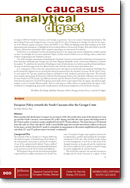Women's Political Participation in Armenia: Institutional and Cultural Factors

Autor(en): Gohar Shahnazaryan
Herausgeber: Karolina Ó Beacháin Stefanczak (special editor), Denis Dafflon, Lili Di Puppo, Iris Kempe, Natia Mestvirishvili, Matthias Neumann, Robert Orttung, Jeronim Perovic, Heiko Pleines
Serie: Caucasus Analytical Digest (CAD)
Ausgabe: 71
Seiten: 9-13
Verlag(e): Center for Security Studies (CSS), ETH Zurich; Research Centre for East European Studies, University of Bremen; Institute for European, Russian and Eurasian Studies, George Washington University
Publikationsjahr: 2015
